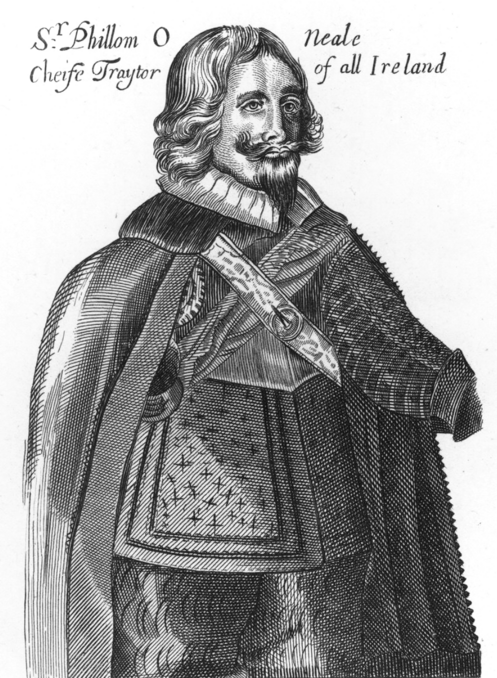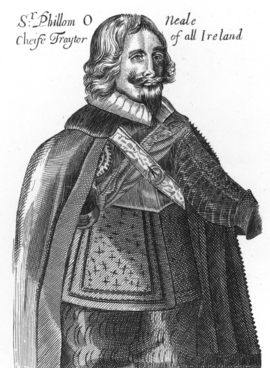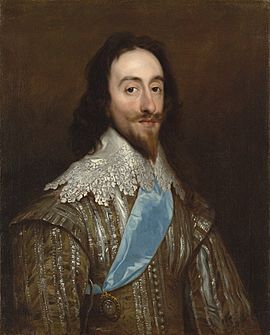Felim O'Neill of Kinard facts for kids
Quick facts for kids
Sir Phelim O'Neill
|
|
|---|---|
|
Detail of the portrait further down
|
|
| Born | About December 1604 |
| Died | 10 March 1653 |
| Family | O'Neill dynasty |
| Spouse(s) | Jean Gordon |
| Issue Detail |
Gordon O'Neill |
| Father | Turlough MacShane O'Neill |
| Mother | Catherine O'Neill |
Sir Phelim O'Neill (born around 1604, died 1653) was an important Irish leader and soldier. He is known for starting a major uprising in Ulster, Ireland, in 1641. This event was called the Irish Rebellion. Later, he joined the Irish Catholic Confederation, a group that fought for Catholic rights in Ireland. He was a commander in the Confederate Ulster Army during the Wars of the Three Kingdoms. After a period of hiding, O'Neill was captured, put on trial, and executed in 1653.
Contents
Early Life and Family
Phelim O'Neill was born in 1604. He was the oldest son of Turlough MacShane O'Neill and Catherine O'Neill. His family belonged to a powerful Irish clan called the O'Neill dynasty. They were part of the Kinard branch of this family.
Sadly, Phelim's father and grandfather were killed in 1608 while defending their home during another rebellion. His grandfather, Sir Henry Óg O'Neill, had fought in an earlier war but was later pardoned.
Phelim's mother, Catherine, was from another branch of the O'Neills. After Phelim's father died, she married Robert Hovenden. Phelim had two half-brothers from this marriage, Robert and Alexander. Alexander later died fighting alongside Phelim in 1644.
Education and Marriages
In 1621, Phelim went to a law school in London called King's Inns. Learning about law was important for landowners back then. For a short time, he became a Protestant, but he soon returned to being a Catholic.
Phelim was married three times. His first wife was the daughter of Arthur Magennis, a Viscount. Her name is not known. In 1639, he was made a knight in Dublin. This happened thanks to a relative, the Earl of Antrim.
Before the rebellion, Phelim made a controversial decision. He removed some of his Irish tenants from their lands near Kinard. He replaced them with British families who paid more rent.
In 1641, Phelim became a Member of Parliament (MP) for Dungannon (Parliament of Ireland constituency). This meant he represented his area in the Irish Parliament. His first wife passed away in September 1641. He then married his second wife, Louise. Later, in 1649, he married his third wife, Jean Gordon.
The Irish Rebellion of 1641
Many Irish Catholics, especially those from old Irish families, felt worried by the Protestant English government in Ireland. They were upset because Catholics were not allowed to hold public jobs. Also, the government kept taking land from Catholic owners. Phelim O'Neill himself was in a lot of debt, which added to his problems.
The Plan to Rebel
These fears grew stronger in the late 1630s and early 1640s. The English King's representative in Ireland, Thomas Wentworth, was planning to take even more land from Irish Catholics. Things became very tense in 1641. Scottish and English groups threatened to invade Ireland to fully control Catholicism there.
In this time of fear, Phelim O'Neill joined a secret plan. Other Irish Catholic leaders from Ulster wanted to capture Dublin and other important Irish towns. Their goal was to demand full rights for Catholics and for Ireland to govern itself. Phelim's job was to take control of towns and forts in the north of Ireland.
Phelim joined the plot in September 1641. On October 23, 1641, he surprised Lord Caulfeild and took Charlemont Fort. Phelim played a big part in deciding what the rebellion wanted to achieve. He quickly became the leader of the uprising in Ulster.
The Uprising Begins
However, the plan to take Dublin failed. Two of the plotters were caught by the authorities. Phelim went ahead and started the rebellion in the north. He captured Charlemont Fort, which was an important stronghold. But he soon found it hard to control the Irish Catholic people who had joined him.
Many of these people had lost their land in earlier times. They began attacking Scottish and English Protestant settlers. These attacks happened over about five months. Because Phelim was in charge, some people blamed him for these violent events. The exact details of these massacres are still debated by historians.
On October 24, 1641, Phelim O'Neill issued a statement called the Proclamation of Dungannon. In it, he claimed that King Charles I of England had given him permission to rise up. He said the King wanted him to defend the Crown and the Catholic religion. On November 4, 1641, Phelim repeated these claims. He even read out a document that he said was from King Charles. This made his forces believe they were acting legally. However, King Charles later said he never issued such a document.
In November, Phelim attacked Lisburn several times but could not capture it. Like other rebel leaders, Phelim had trouble keeping his troops disciplined. He tried to improve this by planning to declare himself the Earl of Tyrone.
Joining the Confederates
The rebellion quickly spread across Ireland. By the spring of 1642, only a few Protestant areas, like Dublin, Cork, and Derry, were still holding out. King Charles I sent a large army to Ireland. This army might have stopped the rebellion, but then the English Civil War broke out in England.
This gave Irish Catholic leaders time to form the Irish Catholic Confederation. This group acted like an independent government for Ireland until 1649. Phelim O'Neill was a member of their main assembly. However, wealthier landowners soon took over the main leadership roles.
Phelim also lost his top military position. After a big defeat in 1642 at the Battle of Glenmaquin, his relative, Owen Roe O'Neill, arrived from the Netherlands. Owen Roe was a professional soldier and was made the general of the Confederate's Ulster army. Phelim O'Neill then served as a cavalry commander under him. For the next six years, he mostly fought against the Scottish army that had come to Ulster. He was part of the Confederate victory at the Battle of Benburb in 1646.
In Confederate politics, Phelim O'Neill was a moderate. He wanted to make a deal with King Charles I and the English Royalists. He believed this was the best way to win the war against the English Parliament and the Scottish forces. In 1648, he voted for such a deal, called the Second Ormond Peace. This caused a disagreement with Owen Roe O'Neill and most of the Ulster army, who were against the deal. Phelim and other moderates left the Ulster army because of this. That summer, the Confederate armies even fought among themselves over the issue. The groups supporting the King won these internal battles.
However, these efforts were not enough to stop Ireland from being conquered by Oliver Cromwell's army in 1649–53. Cromwell's well-trained forces defeated all Confederate and Royalist resistance. They then imposed harsh rules on Irish Catholics.
Final Battle and Capture
Phelim O'Neill fought in the Ulster Army at the Battle of Scarrifholis in 1650. His army was badly defeated there. Phelim escaped the battle and went with the rest of the Ulster army to Charlemont Fort. With his stepson, he defended the fort against the English. They caused many losses for the English troops during the Siege of Charlemont.
However, they surrendered on August 6, 1650. The agreement allowed Phelim and his remaining troops to leave and go to France. But Phelim decided to go into hiding instead.
Trial and Execution
Anyone involved in the Rebellion of 1641 was blamed for the attacks on Protestant civilians. They faced execution. Phelim O'Neill was specifically named as a leader in a law passed by Cromwell's government in 1652. This meant he could not expect any mercy. A reward of £100 was offered for his capture.
Phelim O'Neill was caught on February 4, 1653. He was found hiding on a small artificial island in Roughan Lough, near Roughan Castle. He was taken to Dublin for his trial. He was found guilty of treason and executed on March 10, 1653.
Phelim might have avoided execution if he had claimed that King Charles I had given him permission for the uprising. The Parliamentarians wanted him to say this. However, Phelim refused to do so. He had at least one child, Gordon O'Neill, who later became a colonel in the Jacobite forces during another war.
| Timeline | ||
|---|---|---|
| Age | Date | Event |
| 0 | 1604 | Born |
| 4 | 1608, 20 Jun | Father and grandfather killed during O'Doherty's rebellion |
| 17 | 1621, Jun | Began studying law at King's Inns. |
| 25 | 1629 | Married his first wife. |
| 35 | 1639, 17 Mar | Knighted in Dublin. |
| 37 | 1641, 28 Oct | Captured Charlemont Fort. |
| 37 | 1641, 28 Nov | Failed to take Lisburn. |
| 38 | 1642, 6 Jul | Lost the Battle of Glenmaquin. |
| 42 | 1646, 5 Jun | Fought at the Battle of Benburb. |
| 45 | 1649, Nov | Married his third wife, Jean Gordon. |
| 46 | 1650, 21 Jun | Fought at the Battle of Scarrifholis. |
| 46 | 1650, 6 Aug | Surrendered Charlemont Fort. |
| 49 | 1653, 10 Mar | Executed for treason. |
Images for kids





